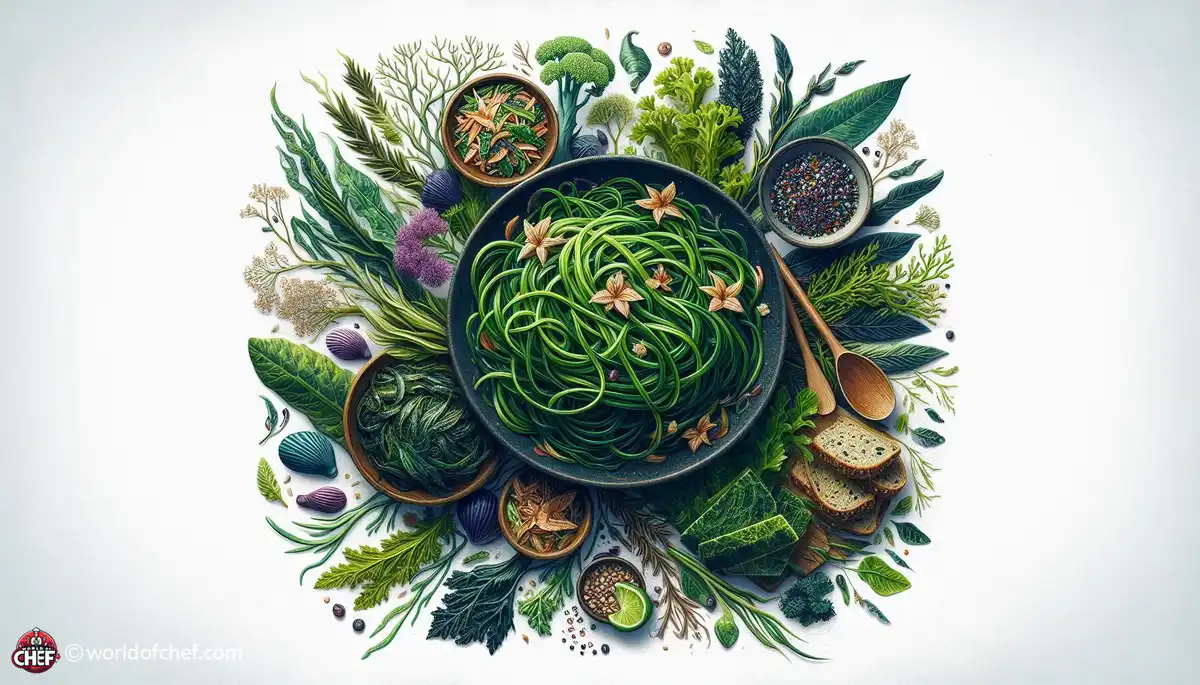
Unveiling the Power of Cruciferous Vegetables in Cancer Prevention
Eloise Jester - Mar 26, 2025 - 8 min read


Sea vegetables, also called seaweeds, are one of the most nutritious superfoods that have been integral parts of various cuisines worldwide for centuries. Being packed with a rich, unique umami flavor and a high nutrient profile, sea vegetables are gaining great popularity in modern cooking. From nori to kelp, these ocean gems present a variety of textures and flavors that can lift up any dish. In this blog post, we will dig into the sea vegetables' world and see ten recipes that are quite delicious to try.
Sea vegetables are scrumptious and packed with nutritious goodness. Packed full of vitamins, minerals, and antioxidants, they go a long way in nutrition. They are a reservoir of iodine, that is needed for thyroid activities, calcium, which in turn maintains bone health, along with other minerals and plenty of vitamins. They further contain fucoidans and alginate, specific compounds unique to sea veggies, which have been reportedly linked to various healthpromoting effects, including their anti-inflammatory and immune boosting properties.
It would appear that sushi rolls come from Japan and can vary without any limitations in terms of how creative the fillings and overall rolls can be. To include nori into sushi, you wrap nori sheets around the rice with your fillings, meaning that you add not just the oceanic flavor from nori but also provide your dish with much greater nutritional value. Nori contains vitamins and minerals: vitamin C, vitamin A, and iodine-boosting the nutrition to it.
Take the classic California roll and upgrade it with seaweed in this recipe. Prepare sushi rice and cut your favorite fillings, such as avocado, cucumber, and crab or imitation crab. Lay out a sheet of nori on a bamboo sushi mat, spread the rice evenly over the nori, and arrange the fillings in the center. Use a bamboo mat to roll the sushi very carefully and then slice into pieces for serving with soy sauce, wasabi, and pickled ginger to provide a nutritious twist to the classic sushi rolls.
This refreshing taste and crunchy seaweed salad is a common component of Japanese cuisine; however, it is not the most delicious dish. On the other hand, its creation from wakame-the brown seaweed - shows how nutritious it really is. Wakame seaweed is rich in vitamins A, C, and E, as well as calcium, magnesium, and iodine. It is even found to contain a specific compound called fucoxanthin, which has recently attracted much attention for health reasons, including anti-inflammatory effects and anti-obesity results.
This is a classic Japanese salad, easy to make. Soak dried wakame seaweed in water. Drain the softened seaweed and mix it with thinly sliced cucumbers, sesame seeds, and a dressing made from soy sauce, rice vinegar, sesame oil, and a little sugar. Chill the salad for at least 30 minutes in the refrigerator so the flavors can meld together. Serve cold as a refreshing side dish or a very light and nutritious snack.
Miso soup is the quintessential Japanese dish whose deliciously flavored broth contains fermented soybean paste. When kombu, or kelp, is added to the broth, you are not only enhancing the umami flavor of the broth but also topping it off with even more nutrition. Kombu is rich in iodine, calcium, and iron and can thus be considered as one of the more nutritious components of any soup or broth. It has glutamic acid, the amino acid that gives miso soup a savory flavor so very characteristically.
Make this comforting soup by starting with soaking a piece of kombu to rehydrate it. Once the kombu has rehydrated, remove the kombu from the liquid and transfer the broth into a pot. Add diced tofu, chopped green onion, and the rehydrated kombu to the broth and gently simmer, allowing the tofu to become heated through. Finally, whisk miso paste dissolved in a little of the broth into the soup. Serve hot, garnished with additional chopped green onions for a warm and healthy dish.
Tempura is perhaps one of the most known Japanese dishes; it uses lightly battered and fried seafood or vegetables. It can present a rather unique and scrumptious twist on this classic using crispy seaweed as the base ingredient. Seaweed tempura is fragile, with an excellent flavor which goes along with a light and crisp batter. Plus, as seaweed is full of vitamins, minerals, and antioxidants, it's that much healthier an alternative compared to what is usually used to make the traditional kind.
Make a simple tempura batter by mixing flour, cornstarch, baking powder, and cold water. Cut sheets of dried seaweed into bite-sized pieces and dip them into the batter until evenly coated. Lower the seaweed pieces carefully into hot oil and fry until golden brown and crispy. Remove from the oil and drain on paper towels to remove excess oil. Serve hot with soy sauce or a tangy dipping sauce for a crunchy snack with great flavor.
Risotto is one of the oldest classic Italian dishes, which comes in a Creamy Texture with the rich flavor. Add some seaweed and mushrooms into the risotto and enjoy the umami taste it can bring. Adding seaweed gives depth in the flavor and nutrition while earthy notes and a meaty texture are provided by the mushrooms. They blend well to make the best dish for any time of the day.
Sauté chopped onions and garlic in olive oil until softened, add the arborio rice, and toast until lightly golden. Gradually add in hot vegetable broth while stirring constantly until the rice is creamy and tender. Pan-fry sliced mushrooms until golden and tender, and add in the rehydrated seaweed and cook until heated through. Add mushrooms and seaweed to risotto and grate in some Parmesan cheese with a knob of butter. Season with salt and pepper to taste and serve hot topped with chopped parsley.
Ramen is a highly revered Japanese noodle soup characterized by its rich, thick broth and hearty topping. Infusing the dashi into the broth from kombu and bonito flakes will give it depth in flavor that perfectly combines with the seaweed topping and other toppings. The umami flavor of the dashi is richly nutritious, making it ideal for a nourishing, satisfying bowl of ramen.
Recipe: Simmer kombu and bonito flakes for about 30 minutes to make dashi stock. Strain the stock back into the pot and season with soy sauce, mirin, and sake to taste. Cook ramen noodles according to package instructions and divide them among serving bowls. Top with sliced cooked pork, shredded green onions and nori seaweed sheets. Ladle the hot dashi broth over the noodles and toppings, serve promptly to create a delicious and wholesome meal.
Classic Italian pesto pasta is so fresh, vibrant with herbs, garlic, nuts, and cheese. The following is how to make pesto a little bit different from others: this one would be using seaweed, giving it an ocean flavor and a nice green hue. It is full of vitamins, minerals, and antioxidants. Use this sea pesto pasta with cherry tomatoes as a light dish for any kind of special occasion.
Make your seaweed pesto pasta by pulsing together fresh basil, garlic, pine nuts, Parmesan cheese, and rehydrated seaweed in a food processor until it is smooth. With the motor running, slowly add olive oil in a steady stream until your pesto reaches the consistency you prefer. Cook pasta according to package instructions. Toss with the seaweed pesto until pasta is evenly coated. Serve pasta with halved cherry tomatoes finished with a little extra Parmesan for a pop of freshness and color.
Stir-fries are fast foods that can add sea vegetables to your meals. Combining seaweed with tofu together with other vegetables, then you get a flavorful, nutritious dish within minutes of preparation. Seaweed will add a flavor due to its umami besides providing a pleasing chew to the stir-fry and the tofu as a very good source of plant protein. Combine the seaweed and tofu stir-fry with steamed rice in order to create a total satisfying meal.
Let's use firm tofu cut into cubes and dried seaweed that has been rehydrated in water. Heat the oil in a wok or large skillet over medium-high heat. Add the tofu, stir-frying until golden brown on all sides. Remove the tofu from the pan and set aside. Add sliced vegetables such as bell peppers, broccoli, and snap peas to the pan. Stir-fry until the vegetables are crisp-tender. Add the rehydrated seaweed and cooked tofu back into the pan. Drizzle a sauce made from soy sauce, garlic, ginger, and a touch of sesame oil over the top, then toss to coat. Serve immediately over steamed rice to get a quick, hot flavorful meal.
Seaweed chips are deliciously crunchy, nutritious alternatives to traditional potato chips. Lightly seasoned and roasted dried sheets of seaweed can be so flavorful and crunchy. Since seaweed is naturally low in calories and fat but rich in vitamins, minerals, and antioxidants, it's the perfect guilt-free snack. You can enjoy seaweed chips alone or as a crunchy topping for salads, soups, or stir-fries.
Prepare an oven and a baking sheet, then line the latter using parchment paper. Take a piece of dried seaweed sheets and place it onto the baking sheet, where lightly brush it with a couple of drops of sesame or olive oil. Your options for seasonings at this point include salt and pepper, garlic powder or chili flakes. Bake for 10-15 minutes, or until the seaweed is crispy and is lightly golden at edges. Allow it to cool completely before serving. Enjoy your homemade seaweed chips as a healthy snack anytime.

Eloise Jester - Mar 26, 2025 - 8 min read

Wayne Tobar - Mar 23, 2025 - 6 min read

Harold Turcios - Mar 19, 2025 - 7 min read

Nevaeh Zeng - Mar 16, 2025 - 6 min read